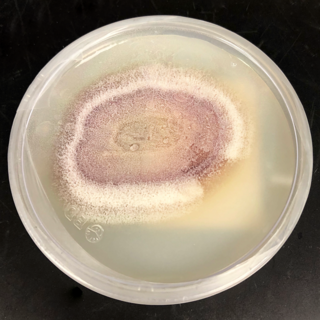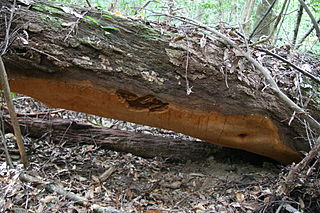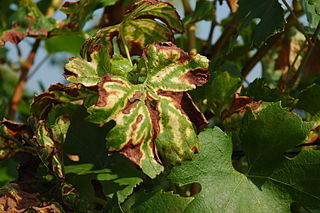
Frogfishes are any member of the anglerfish family Antennariidae, of the order Lophiiformes. Antennariids are known as anglerfish in Australia, where the term "frogfish" refers to members of the unrelated family Batrachoididae. Frogfishes are found in almost all tropical and subtropical oceans and seas around the world, the primary exception being the Mediterranean Sea.

Plasmopara viticola, the causal agent of grapevine downy mildew, is a heterothallic oomycete that overwinters as oospores in leaf litter and soil. In the spring, oospores germinate to produce macrosporangia, which under wet condition release zoospores. Zoospores are splashed by rain into the canopy, where they swim to and infect through stomata. After 7–10 days, yellow lesions appear on foliage. During favorable weather the lesions sporulate and new secondary infections occur.
Xiphinema diversicaudatum is an amphimictic ectoparasitic nematode species. This species has a characteristically long stylet capable of penetrating into a host's vascular tissue. They have a wide host range with some of the extensively studied ones being strawberry, hops and raspberry, due to their economic importance. The direct root damage caused through penetration near the root tip and formation of galls is a secondary concern when compared with the damage caused by vectoring the Arabis mosaic virus. The virus attaches to the interior cuticle lining and can be transferred from infected to uninfected root tissue as the nematode feeds and sheds. Management of this particular nematode relies on nematicides such as 1,3-Dichloropropene (Telone) at 40 gpa.or methyl bromide at 1000 lb/ac to control to 28 in deep.

Vitis (grapevine) is a genus of 79 accepted species of vining plants in the flowering plant family Vitaceae. The genus is made up of species predominantly from the Northern Hemisphere. It is economically important as the source of grapes, both for direct consumption of the fruit and for fermentation to produce wine. The study and cultivation of grapevines is called viticulture.

The Hymenochaetaceae are a family of fungi in the order Hymenochaetales. The family contains several species that are implicated in many diseases of broad-leaved and coniferous trees, causing heart rot, canker and root diseases, and also esca disease of grapevines. According to a standard reference text, the family contains 27 genera and 487 species.

Fomitiporia is a genus of fungi in the family Hymenochaetaceae. According to a 2008 estimate, the widely distributed genus contains 11 species, though three new species were identified in 2010 in sub-Saharan Africa using multigene molecular phylogenetic analysis, and two more were named in a 2013 article. In 2011 it was announced that a specimen of the species F. ellipsoidea was discovered with a fruit body that is largest known of any fungus. However, the species has since been moved to Phellinus.

The Wonderfish (Thaumatichthys) is a genus of deep-sea anglerfish in the family Thaumatichthyidae, with three known species. Its scientific name means "wonder-fish" in Greek; oceanographer Anton Bruun described these fishes as "altogether one of the oddest creatures in the teeming variety of the fish world." In contrast to other anglerfishes, the bioluminescent lure of Thaumatichthys is located inside its cavernous mouth. They are worldwide in distribution and are ambush predators living near the ocean floor.

The anglerfish are fish of the teleost order Lophiiformes. They are bony fish named for their characteristic mode of predation, in which a modified luminescent fin ray acts as a lure for other fish. The luminescence comes from symbiotic bacteria, which are thought to be acquired from seawater, that dwell in and around the sea.

Phaeoacremonium is a fungus genus associated with wilt and decline diseases of woody hosts and human infections.

Phellinus ellipsoideus is a species of polypore fungus in the family Hymenochaetaceae, a specimen of which produced the largest fungal fruit body ever recorded. Found in China, the fruit bodies produced by the species are brown, woody basidiocarps that grow on dead wood, where the fungus feeds as a saprotroph. The basidiocarps are perennial, allowing them to grow very large under favourable circumstances. They are resupinate, measuring 30 centimetres (12 in) or more in length, though typically extending less than a centimetre from the surface of the wood. P. ellipsoideus produces distinct ellipsoidal spores, after which it is named, and unusual setae. These two features allow it to be readily differentiated microscopically from other, similar species. Chemical compounds isolated from the species include several steroidal compounds. These may have pharmacological applications, but further research is needed.

Esca is a grape disease of mature grapevines. It is a type of grapevine trunk disease.
Phaeomoniella is a genus of hyphomycete fungi in the family Celotheliaceae. The genus was circumscribed by Pedro Crous and Walter Gams in 2000 to contain the type species, P. chlamydospora, the causal agent of Petro grapevine decline, a disesase in the esca disease complex. Phaeomoniella is similar to Phaeoacremonium, differing in cultural characteristics, and in the morphology of the conidiophores and conidia.
Phaeomoniella chlamydospora is a fungus species of mitosporic ascomycota in the genus Phaeomoniella.
Phaeoacremonium aleophilum is a fungus species in the genus Phaeoacremonium. It is associated with Phaeomoniella chlamydospora in esca in mature grapevines and decline in young vines, two types of grapevine trunk disease.
Grapevine trunk diseases (GTD) are the most destructive diseases of vineyards worldwide. Fungicides with the potential to control GTD have been banned in Europe and there are no highly effective treatments available. Action to develop new strategies to fight these diseases are needed.
Fomitiporia nobilissima is a fungus in the family Hymenochaetaceae. Found in Gabon, it was described as new to science in 2010.
Fomitiporia gabonensis is a fungus in the family Hymenochaetaceae. It was first isolated from Sub-Saharan Africa, specifically in the Guineo-Congolian forest. It has a pileate basidiome, small basidiospores and an absence of setae. Morphological features that differentiate this species with F. nobilissima and F. ivindoensis are its pileus' shape, pore surface color and diameter, as well as its ecology.
Fomitiporia ivindoensis is a fungus in the family Hymenochaetaceae. It was first isolated from Sub-Saharan Africa, specifically in the Guineo-Congolian forest. It has a pileate basidiome, small basidiospores and an absence of setae. Morphological features that differentiate this species with F. nobilissima and F. gabonensis are its pileus' shape, pore surface color and diameter, as well as its ecology.
Celotheliaceae is a family of fungi in the monotypic order Phaeomoniellales. It contains 27 species of crustose lichens with thalli that are more or less immersed in tree bark.

The 2020 table grape harvest was worth $2.12 billion while wine grapes brought in $1.7 billion, down 15.3% year-on-year. By weight this was 17% lower versus 2018. The next year, 2021 saw a much better yield. From 829,000 acres (335,000 ha) viniculturists got 6.94 short tons per acre (15.6 t/ha) for a total harvest of 5,755,000 short tons (5,221,000 t). At an average of $909 per short ton ($1,002/t) they were paid $5,229,902,000 for the season. Of that, 4,844,600 short tons (4,394,900 t) were for destined for processing industries and at $835 per short ton ($920/t) that was worth $4,046,382,000. The fresh harvest was 910,400 short tons (825,900 t) and selling at a price of $1,300 per short ton ($1,433/t), this sector was worth $1,183,520,000 for the season.










